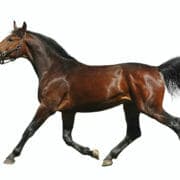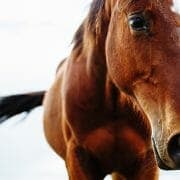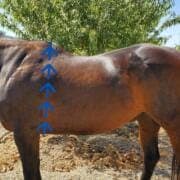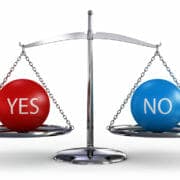Why Body Condition Score?
Feeding your horse the right amount of feed is important to:
- Prevent unwanted weight loss or weight gain
- Prevent diseases like colic and gastric ulcers
- Prevent unruly, uncontrolled behavior when being ridden
The question is, how do you know how much to feed your horse? Keep reading to find out how body condition scoring can help you answer this crucial question.
How much should you feed your horse?
The first golden rule of horse feeding is always feed your horse a minimum of 1.5% of its bodyweight per day of forage. So, for a 500 kg horse, the absolute minimum amount of hay, pasture and chaff it should have access to per day is 7.5kg. Your horse should preferably be fed around 2% of its bodyweight per day as forage. Feeding this amount of forage will keep your horse’s gut healthy, keep your horse happy and help prevent colic and gastric ulcers.
The question then is, is this amount of forage enough to maintain your horse’s bodyweight? The only way you can answer this question is by regularly condition scoring your horse. Condition scoring is a practice used to determine the amount of body fat your horse is carrying and will give you an indication over time whether your horse is gaining, holding or losing weight. This in turn helps to fine tune your horse’s diet.
Condition Scoring
Condition scoring of horses involves an assessment of certain parts of a horse’s body for ‘fatness’. The most commonly used sites are the along the neck, along the withers, the loin, tailhead, ribs and behind the shoulder as shown below.
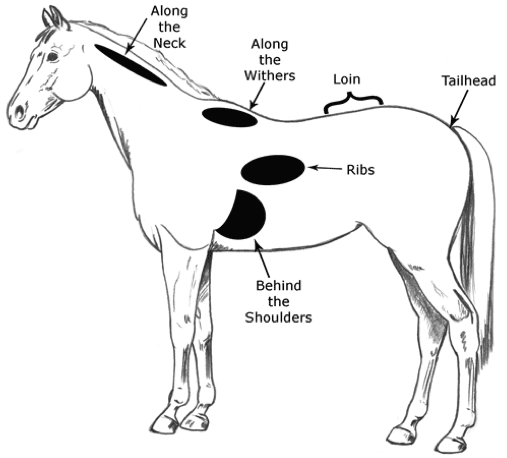
Once an assessment of these areas of the horse’s body is made, a system developed by researchers at the Texas A&M University, USA (Henneke et al. 1983), may be used to assign a ‘score’ to reflect your horse’s level of body fatness. This condition scoring system presents condition scores on a scale of 1 to 9, with 1 being extremely emaciated and 9 being extremely fat.
Here’s a description of all the body condition scores (with pictures):
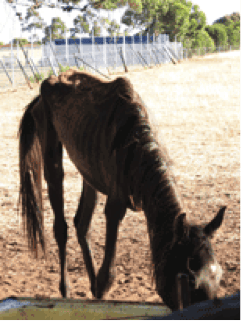
Score 1 — Poor
The horse is extremely emaciated. The bone structures of the neck, wither and shoulders are easily visible. The ribs, backbone and tailhead project prominently.
 Score 2 — Very Thin
Score 2 — Very Thin
The horse is emaciated. The bone structures of the neck, wither and shoulders are faintly discernable. The structure of the ribs, backbone and tailhead are prominent.
 Score 3 — Thin
Score 3 — Thin
The structure of the neck, wither and shoulders are accentuated. There is a slight fat cover over the ribs but they remain easy to see. The vertebrae of the backbone are easily discernable and the tailhead is prominent but the bone structure of the tailhead is not obvious.
 Score 4 — Moderately Thin
Score 4 — Moderately Thin
The neck, wither and shoulders are not obviously thin. A faint outline of the ribs is visible, the backbone projects upward slightly and some fat can be felt around the tailhead. The prominence of the tailhead will depend on the horse’s conformation.
 Score 5 — Moderate
Score 5 — Moderate
The neck and shoulders blend smoothly into the body and the withers are rounded. The ribs cannot be seen but are easily felt, the area over the loin is flat and the fat deposited around the tailhead begins to feel spongy.
 Score 6 — Moderately Fleshy
Score 6 — Moderately Fleshy
Fat is beginning to be deposited along the neck and withers and behind the shoulder. The ribs can still be felt but the fat cover over the ribs feels spongy. There may be a slight crease or gutter down the back and the fat around the tailhead feels soft.
 Score 7 — Fleshy
Score 7 — Fleshy
Fat is deposited along the neck, wither and behind the shoulder. Individual ribs can still be felt but there is a noticeable filling of fat between the ribs. There may be a crease or gutter down the back over the loin area and the fat around the tailhead will be soft.
 Score 8 — Fat
Score 8 — Fat
The neck is noticeably thickened with fat, the area along the wither is filled with fat and the area behind the shoulder is flush with the body. It is difficult to feel the ribs, there will likely be a gutter down the horses back and the fat around the tailhead will feel very soft.
 Score 9 — Extremely Fat
Score 9 — Extremely Fat
The neck, wither and the area behind the shoulders are bulging with fat. Patchy fat can be seen over the ribs, there is an obvious gutter down the centre of the back and the area around the tailhead bulges with fat.
What condition score should your horse be in?
Depending on what your horse is doing, its optimum condition score will be somewhere between a score of 4 and 7. The table below gives you an indication of the best condition score for your horse.
| Class of Horse | Suggested Condition Score | Notes |
|---|---|---|
| Growing Horse | 5 | Higher condition scores indicate that the diet contains too much feed. The increased body weight at a higher condition score will put excess pressure on immature joints and increases the risk of developmental orthopaedic diseases. |
| Pregnant and/or Lactating Mare | 5 – 7 | Lower or higher body condition scores can reduce fertility and conception rates and decrease milk production. |
| Breeding Stallion | 5 | Lower or higher body condition scores may decrease a stallion’s reproductive performance. |
| Performance Horse | 5 | Horses with lower scores will not have sufficient body fat to use as a reserve source of energy during prolonged or frequent physical activity. Horses with higher condition scores will have increased body heat production, reduced body heat loss and higher heart and respiratory rates. All of these factors will reduce performance. Excess weight also increases the strain placed on the skeletal system. |
| Idle Horse | 4 – 6 | Will vary depending on the individual horse, climate and season. |
If your horse has a lower condition score than it should, you need to feed more. If your horse has a higher condition score than it should have, you need to feed less.
FeedXL helps you to adjust your horse’s diet according to the horse’s body condition score and whether it needs to gain or lose weight, making knowing how much to feed and what to feed to your horse simple.
FeedXL helps you adjust your horse’s diet to manage its weight
When entering your horse’s details into FeedXL it asks you your horse’s body condition score, if your horse is an easy keeper (gains weight easily), normal keeper or hard keeper (loses weight easily) and if you want your horse to lose, hold or gain weight.
Using the answers to those questions, FeedXL will adjust your horse’s estimated energy (calorie) requirements to help you achieve your horse’s body weight goals. All you need to do is meet these estimated energy requirements with a green bar in FeedXL and then continue to monitor your horse’s condition score to keep track of progress.
Interested in learning how to estimate your horse’s weight? Read more here: Body Weight Estimation: Which Method Is Best?
Join FeedXL today and take control of your horse’s nutrition
Get EVEN MORE practical and personalised feeding guidance when you sign up to FEEDXL.
Do you have a question or comment? Do you need help with feeding?
We would love to welcome you to our FeedXL Horse Nutrition Facebook Group. Ask questions and have them answered by PhD and Masters qualified equine nutritionists and spend time with like-minded horse owners. It’s free!
Click here to join the FeedXL Horse Nutrition Facebook Group

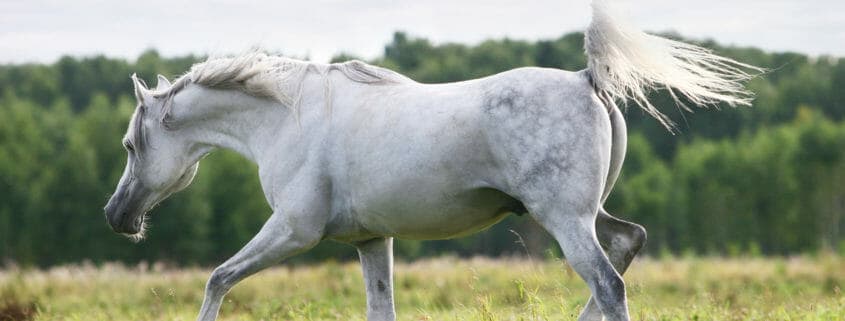

 Score 2 — Very Thin
Score 2 — Very Thin Score 3 — Thin
Score 3 — Thin Score 4 — Moderately Thin
Score 4 — Moderately Thin Score 5 — Moderate
Score 5 — Moderate Score 6 — Moderately Fleshy
Score 6 — Moderately Fleshy Score 7 — Fleshy
Score 7 — Fleshy Score 8 — Fat
Score 8 — Fat Score 9 — Extremely Fat
Score 9 — Extremely Fat